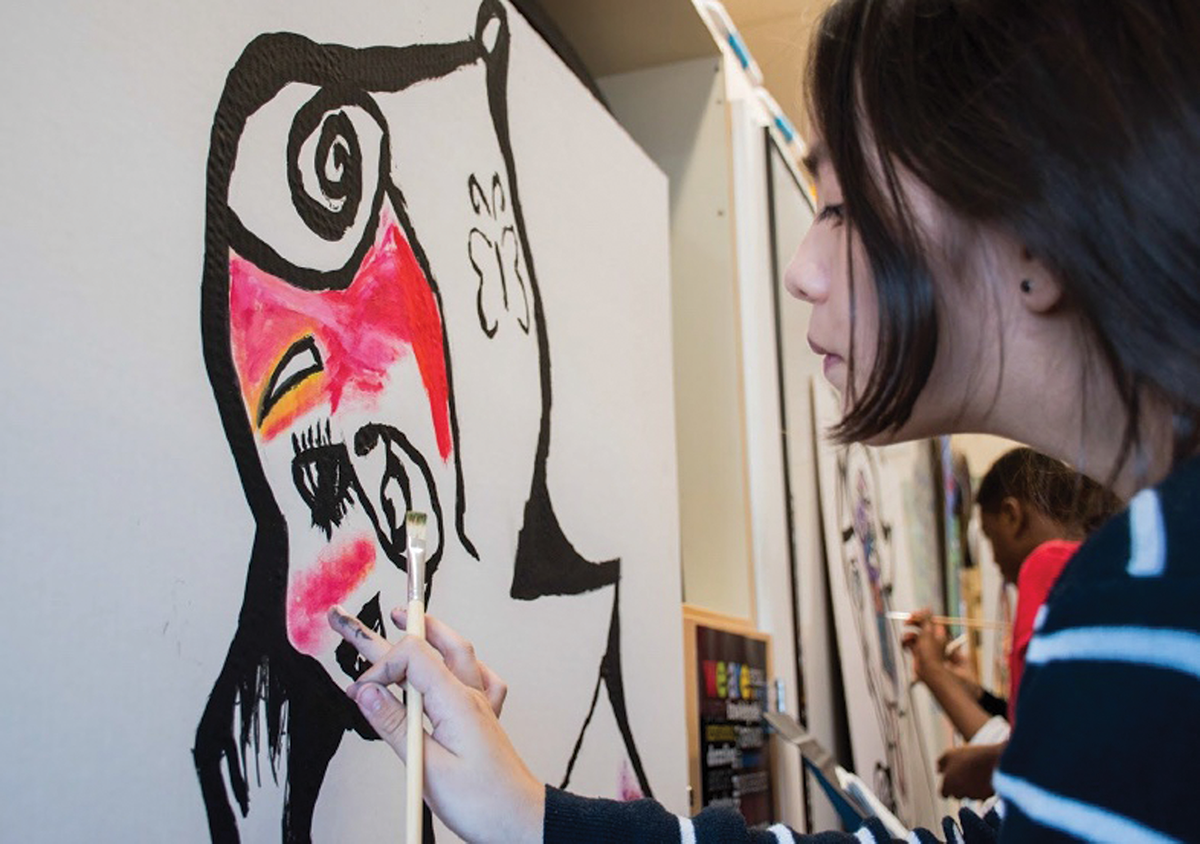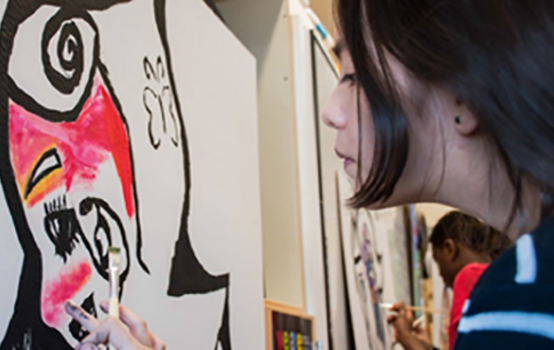
Over the past three years, an urban school district has made great progress in designing and teaching courses that blend academic content with serious instruction in the arts.
In Keith Spencer’s class, students are making a set of colorful, larger-than-life puppets; in Lisa Norberg’s class, they’re immersed in the subtleties of design thinking. Neither of them is an art teacher, though — Spencer is a 7th-grade English teacher, and Norberg teaches 7th-grade social studies. However, like most of the academic teachers in three K-8 schools in Everett, Mass., they are committed to providing their students with opportunities to blend their learning of core academic subjects with artistic expression and engagement.
Everett is an urban district with high percentages of English learners and students living in poverty, and like many school systems in economically stressed parts of the country, it offers only limited amounts of traditional arts and music instruction — roughly one class every seven days for most students. However, its embrace of arts integration has enabled it to provide meaningful access to many kinds of music, visual art, and theater, reaching students on almost a daily basis.
Arts integration in practice
Inspired by the growing movement to integrate the arts into other parts of the K-12 curriculum, the Everett schools pursued, and in 2013 were awarded, a grant from the federal Arts in Education Model Development and Dissemination program. To help them design and launch their approach, district leaders contracted with SmART Schools, a national arts-in-education program that supports schools and districts across the country. And, in turn, SmART Schools created professional development and classroom services for Everett’s middle grades teachers. Shortly before the school year began, 50 of them participated in a weeklong summer institute, which featured instructional coaching by master teaching artists from colleges and arts organizations throughout the region. Just a couple of weeks later, the teachers were implementing an array of new strategies in their own classrooms.

Students bringing a myth to life. (Photo: Keith Spencer, Keverian School, Everett, Mass.)
Puppets and performance
For Keith Spencer’s students, the puppet-making project was linked to their study of Greek mythology, specifically the story of Daedalus and Icarus, in which a father and son escape imprisonment — and the Minotaur, a monstrous human/bull hybrid — using wings they’ve made from bird feathers and wax. The idea was for students to create and perform their own version of the story, and in the process to dig deeper into its themes (including topics such as hierarchy, pride, ambition, and mortality).
The lesson began with a simple sketching exercise in which students were prompted to draw something on paper (e.g., “Add four lines”), pass it to the person on their left, make an addition to the drawing they’ve received from the person on their right, and so on. Eventually, each sketch made its way around the class — becoming a drawing made with everybody’s input — and back to the student who had started it. Next, the students were asked to edit the drawings, turning their peers’ collected marks and doodles into designs for puppets based on the story.
Once the designs were finished, the students selected the best ones to enlarge and turn into puppets. Spencer then copied the images onto transparencies and, using an overhead projector, projected them onto a wall, so the students could transfer the scaled drawings onto white cardboard, shape them, and paint them using a dry-brush technique. The completed works were colorful, larger-than-life creatures, and the students took enormous pride in seeing them transformed in this way.
The next step was to use the puppets as tools for storytelling, interpretation, and theatrical performance, employing a teaching strategy that Spencer had learned during the summer institute from the master teaching artist Erminio Pinque, an instructor at the Rhode Island School of Design (RISD) and founder of Big Nazo Puppets, a well-known performance art group also based in Providence, R.I. With help from Spencer, Pinque, and the school’s theater arts specialist, the students chose selections from the story, created props, learned to project their voices, came up with stage directions, and rehearsed lines and scenes, all in preparation for a live performance before an audience of 6th graders.
Again, keep in mind that Spencer is a language arts teacher, not an arts specialist. But after receiving a modest amount of professional development and coaching, he was able to incorporate a number of artistic forms and techniques into his instruction. By his own estimation — and according to ratings and comments in student surveys — the effort has been a great success, making his class much more engaging and leading students to take greater care, pride, and a sense of accomplishment in their work.
Finally, not only did the unit focus on a number of the district’s ELA standards (addressing literary themes, character analysis, story structure, and more), but it also provided meaningful instruction in both the visual and performing arts, touching on several of the National Core Arts Standards (www.nationalartsstandards.org), including specific 7th- grade anchor standards for the visual arts (e.g., the exploration of various materials and techniques, the understanding of quality craftsmanship, attention to detail) and theater arts (e.g., performance, character development, and stagecraft).

Applying color using a dry-brush technique. (Photo: Keith Spencer, Keverian School, Everett, Mass.)
Darts and design
At the summer institute, one of the other master teaching artists, Amy Leidtke (also a RISD faculty member), had shown Everett’s teachers a powerful way to integrate the arts into STEM (Science, Technology, Engineering, & Math) instruction. Specifically, she introduced them to an ancient hunting tool called an atlatl (which was used to hurl darts), showing how it can serve as inspiration for a project that blends engineering and design: Students can study other inventions to send objects sailing through the air (e.g., cannons, slingshots, and tennis rackets; Leidtke demonstrated with a lacrosse stick and a Chuckit, which launches balls for dogs to retrieve) and then design, test, and create a ball-throwing device of their own.
Teachers were enthralled by the activity, recognizing that it would spark students’ creativity, give them a hands-on challenge, and teach them important design principles, all while addressing a number of core science standards. While the project would require materials and tools they hadn’t used previously, many of those materials were recyclables and could be obtained easily. Moreover, the timing was fortuitous since shortly after the start of the school year, ancient tools and weapons would be introduced as part of the social studies curriculum. When Lisa Norberg, a 7th-grade social studies teacher, mentioned to Joe Lento — the science teacher with whom she co-taught — that she’d like to try the activity, he was supportive, recognizing that it would provide a great opportunity for students to see how science, engineering, and design can work together in the real world.
Teachers were enthralled by the activity, recognizing that it would spark students’ creativity, give them a hands-on challenge, and teach them important design principles, all while addressing a number of core science standards.
To help Norberg get the unit started, Leidtke visited the 7th-grade classroom and taught a version of the atlatl lesson, as well as leading students in a discussion about the iterative nature of the design process. It was clear from the outset that the students were hooked. Students were intrigued that such a simple device could bring down an animal as large as the giant mastodon, and they were eager to design and create their own ball-throwing tools.
The next day, Norberg gave them each a few basic tools — a tongue depressor, masking tape, and a can of Play-Doh — and asked them to sketch out some ideas, build initial prototypes, and test them, using their creations to throw jumbo-sized cotton balls across the classroom. Then Norberg upped the ante, asking them to create two or three additional models in limited time, using a wider variety of materials, such as paper cups, chopsticks, wooden dowels, popsicle sticks, clipboards made out of recycled cereal boxes, card stock, foam sheets, tape, and string. Plus, she told them that they would be launching three kinds of balls, made of different materials and having different weights, and she asked them to come up with hypotheses as to how this would affect the distance they would be thrown.
After just 20 minutes, the students were ready to test their models outside. Some of their contraptions didn’t work, and others exceeded expectations, but Norberg reminded them that nobody had failed; this was all part of the iterative process, in which every test helps inform the next design. Once again, the students went back to the drawing board, using what they had learned so far to create two or three more iterations based on their original designs. They embraced the challenge, building and testing new versions before returning to the classroom for a discussion about what worked, what didn’t, and what it would take to improve the designs even further. Finally, Norberg brought the activity full circle by connecting it back to the social studies unit the class was studying, focusing on early civilizations and what the contemporary world can learn from them.
Much as in Keith Spencer’s class, Norberg’s students learned content and skills from more than one field, touching on specific 7th-grade standards in both science and social studies, as well as learning a number of the lessons described in the National Core Arts Standards, having to do with trial and error and the complex, iterative nature of the design process. Further, and unlike most instructional strategies, this one treated failure as a normal, even desirable experience, helping students understand that productive persistence, reflection, and revision are critically important to the work of successful scientists, engineers, artists, and others.
Unlike most instructional strategies, this one treated failure as a normal, even desirable experience, helping students understand that productive persistence, reflection, and revision are critically important.
Ongoing challenges, ongoing commitments
Over the past three years, Everett’s teachers have become increasingly skilled in bringing new classroom approaches to their students, creating active and engaging learning environments that are sorely needed in an age of frequent standardized testing. But even with the in-depth, hands-on training that teachers have received, it hasn’t been easy to design truly successful arts-integrated lessons, and planning them has required intensive collaboration that reaches across departmental boundaries.
To help them meet these challenges, SmART Schools has provided the teachers with two main kinds of support: professional coaching by master teaching artists in visual art, music, and theater, and technical assistance in building and nurturing professional learning communities among participating teacher teams.
Recognizing that both of these kinds of support require careful and ongoing collaboration, the Everett district initiated common planning time in Year Two of the grant. During these 50-minute blocks, teachers meet in grade-level teams — art and music teachers included — to plan curriculum and instruction and reflect on what has and hasn’t worked in the classroom. As many other districts have discovered, however, Everett quickly found that without appropriate training, common planning time can become a waste of valuable teacher resources, devolving into complaint sessions or unfocused discussions. In response, SmART Schools has been working with the district to facilitate meetings and encourage healthy collaboration among teachers, but this remains a work in progress.
Even so, since the arts integration initiative began, student performance has improved significantly in the schools where Keith Spencer and Lisa Norberg teach, with both schools moving from Level Two to Level One status in the Massachusetts rating system. (Level One is the state’s highest designation for proficiency and growth, a status earned by only 29% of the state’s schools last year.) To be sure, Everett’s model of arts integration is evolving, but the district appears to have made a long-term commitment to the approach, and students, teachers, and administrators have only become more enthusiastic about its effect on classroom teaching and learning.
- Related: How to increase arts education
- Related: On the goals and outcomes of arts education: An interview with Lois Hetland
- Related: The art of partnerships: Community resources for arts education
Originally published in April 2017 Phi Delta Kappan 98 (7), 29-33. © 2017 Phi Delta Kappa International. All rights reserved.
ABOUT THE AUTHORS

Eileen Mackin
EILEEN MACKIN is founder and codirector with Robert Mackin of SmART Schools, Portsmouth, N.H.

Robert Mackin
ROBERT MACKIN is founder and codirector with Eileen Mackin of SmART Schools, Portsmouth, N.H.

John Obremski
JOHN OBREMSKI is director of Moving Up SmART and principal of Lafayette Public School, Everett, Mass.

Katherine McKie
KATHERINE MCKIE is SmART Schools grant coordinator, Everett Public Schools, Everett, Mass.










